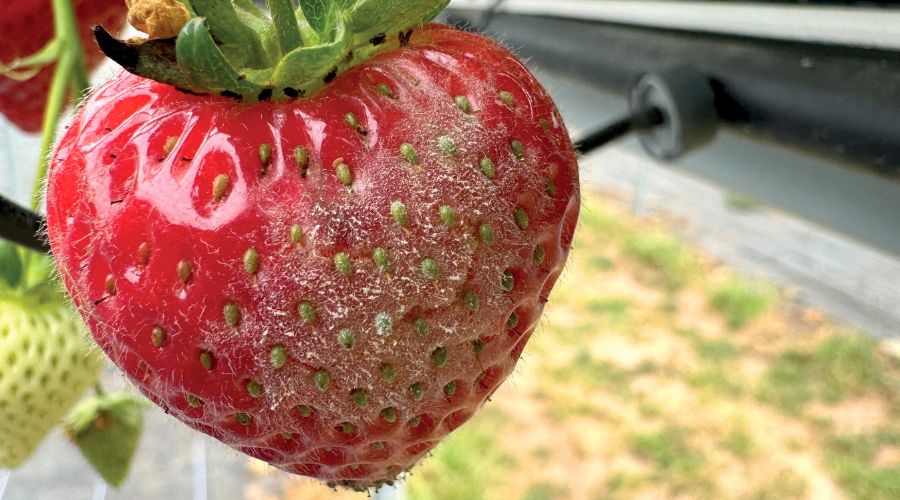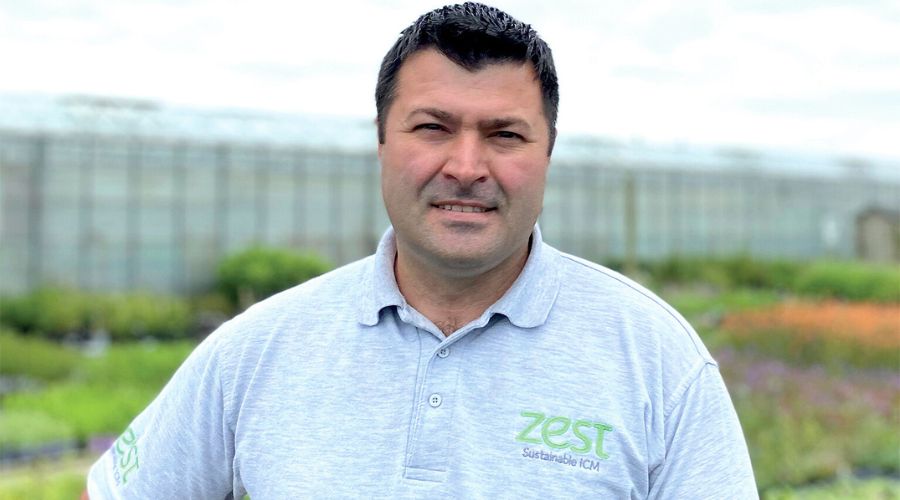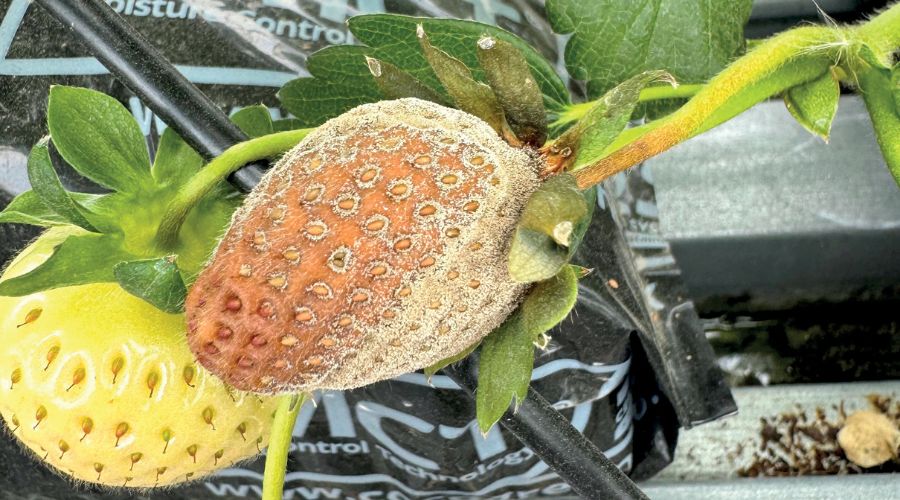Challenging season poses disease & insect control questions
2nd November 2024
Mild, wet conditions have been favourable to disease in soft fruits throughout 2024, requiring proactive control.

It’s been a challenging season all round for growers. The wettest autumn and winter period on record preceded a difficult spring with below-average temperatures and poor sunlight levels hampering growth.
Strawberry growers especially were affected by these less than favourable conditions with crops typically ripening about 10–12 days later than planned. This helped keep prices firm, which was good news for some, but for those with contracts to honour, making good on the volume shortfall proved expensive.
The mild conditions have also been favourable to disease, although in practice there is always a disease of one form or another that does well whatever the season.
“This year, the main focus of strawberry growers has been powdery mildew, especially in the more susceptible varieties,” says Selchuk Kurtev, better known as ‘Semo’, independent consultant at Zest – Sustainable ICM.
“Botrytis cinerea is present, albeit at lower levels despite the favourable conditions,” he adds.
That both botrytis and powdery mildew have not been a problem for growers, perhaps owes much to the proactive nature of disease control programmes employed by growers and the range of fungicides with good efficacy.
For botrytis, Serenade ASO (Bacillus amyloliquefaciens QST 713) remains highly effective and is often used in combination with Teldor (fenhexamid) as part of an integrated programme while Sonata (Bacillus pumilus QST 2808) is a cornerstone of powdery mildew control.
Sonata is especially favoured during cropping for its strong eradicant activity where it fits neatly alongside the contact conventional products.
“It is to the credit of growers that we see such quality produce with so few, if any, exceedances of the maximum residue limits,” Semo says.
UV light research needed
The use of ultraviolet light for pathogen control has created opportunities to further reduce reliance on conventional fungicides. There have been successes with powdery mildew and there is anecdotal evidence that it is useful in reducing the incidence of botrytis and certain soft rots.
“What is unclear, however, is whether the use of UV light as part of an IPM programme for pathogen control interferes with bacillus-based products,” Semo says.
“We need research that considers the effect of UV light on biofungicides and their ability to control disease. We are also seeing the introduction of non-crop protection products claiming incidental control of disease but with the demise of AHDB Horticulture the industry has lost the resources needed to test the validity of these claims,” he adds.

Another crop production difficulty specific to the 2024 season is the lack of crop uniformity caused by the prevalence of crown rot (Phytophthora cactorum) and red core (Phytophthora fragariae).
“We have seen more crown rot and red core than in previous years, especially in the more susceptible types with Malling Centenary being the variety most widely affected. Efforts to control crown rot have been made more difficult by the decline in efficacy of the CAA fungicide, dimethomorph. The need for new fungicides remains as pressing as ever,” Semo explains.
Positive insect control lessons
With the onset of summer and warmer temperatures, spider mite populations have emerged. For aphids, growers have enjoyed more success despite the threat of first flights being up to three weeks earlier than the average over the last 30 years.
Efforts to achieve control of aphids have, in the main, been reasonably successful with many growers seeing near season-long control from a single application of Batavia (spirotetramat).
The performance of conventional insecticides contrasts that seen with biologicals. As a crop, strawberries follow a detailed integrated pest management programme with a heavy reliance on parasitic wasps and predatory mites.
The poor sunlight levels and cool temperatures of spring, however, meant that attempts to establish colonies of the predatory mite Phytoseiulus persimilis, for red spider mite control fell short of expectations. Fortunately, the spring conditions meant that Western flower thrips (Frankliniella occidentalis) populations have remained at low levels.
“Numbers began to build around mid-June with growers proactively applying Neoseiulus (Amblyseius) cucumeris at regular intervals over a four- to six-week period to manage populations depending on levels,” Semo says.

Aphid threats
For raspberry growers where the large raspberry aphid (Amphorophora idaei) and small raspberry aphid (Aphis ideai) are a threat, the feeding blocker, flonicamid remains an effective form of control.
“Where spider mite is a concern, which is especially the case in large canopy cultivars or more susceptible varieties and organic crops, then biological controls often perform well. Unfortunately, this has not been the case this season as the unfavourable start to the summer hampered the establishment of P. persimilis.
“As with strawberry crops, crown rot is a threat as is cane blight on raspberries (Leptosphaeria coniothyrium) and we have already seen a greater incidence of these diseases than is the case in a typical year,” he says.
The need to tackle several species of insect pest at once has highlighted some of the crop protection challenges facing growers. Achieving the desired control without negatively affecting populations of beneficials has resulted in greater use of contact insecticides with a physical mode of action, such as Flipper (fatty acids C7-C20).
“Flipper has been useful this year, especially for spider mite control in conventional strawberry crops and also aphid control in over-wintered 60-day crops or over-wintered everbearer,” Semo notes.
Since its introduction in 2019, Bayer has gone to great lengths to highlight that the effective integration of Flipper relies on proper application. First among these is achieving good coverage of the target pest.
“In modern varieties with dense canopies and vegetative growth this can be challenge, but with the correct water volume, typically 1,400–1,500 litres per ha, and the inclusion of the non-acidifying water conditioner, X-Fusion to support spreadability and adhesion, it has delivered good control,” Richard Phillips, Bayer campaign manager for roots and horticulture crops, says.
The second principle supporting performance is application timing. This applies to population size, its morphological state and the growth stage of the crop.
“All forms of biological crop protection products have been shown to work best when application is made before pest numbers begin to build and not at a level typically associated with the timing of a conventional product,” Richard adds.
“The physiological stage of the pest is also important. It should be after active feeding when the pest can be expected to have a soft cuticle,” he adds.
Flipper, as with contact-acting insecticides in general, is best applied when the pest is stationary and not actively circulating within the crop. It has been found that conditions at application – high light levels, high temperatures, high evapotranspiration rates – can negatively influence efficacy. For this reason, it is best to avoid making applications after 9am and, ideally, when temperatures are 15–18ºC.
The final tenet of good performance is inclusion rate and water quality. Flipper should be applied at a minimum inclusion rate of 1% and mixed with X-Fusion, even with rainwater, as it has been found to support efficacy through improved coverage across the plant surface and the pest.
“We have seen that X-Fusion is more than a water conditioner but also brings beneficial adjuvant properties, so should be included at a rate of 0.2% of spray volume,” Richard says.
Biological measures
The use of biological measures, especially of beneficial predators, has increased steadily over the past 30 years as the industry has come to understand their contribution and their capabilities. As an industry, users are yet to reach the same depth of understanding when it comes to biological insecticides. Perhaps because they come from a can, but it is often the case that growers expect to use these products as they would a conventional insecticide and to see the same results.
“The reality is that these products perform at 50–60% of a conventional insecticide so require more attentive crop management to ensure optimum timing and repeat applications to achieve control,” Richard concludes.
Read more fruit news.
